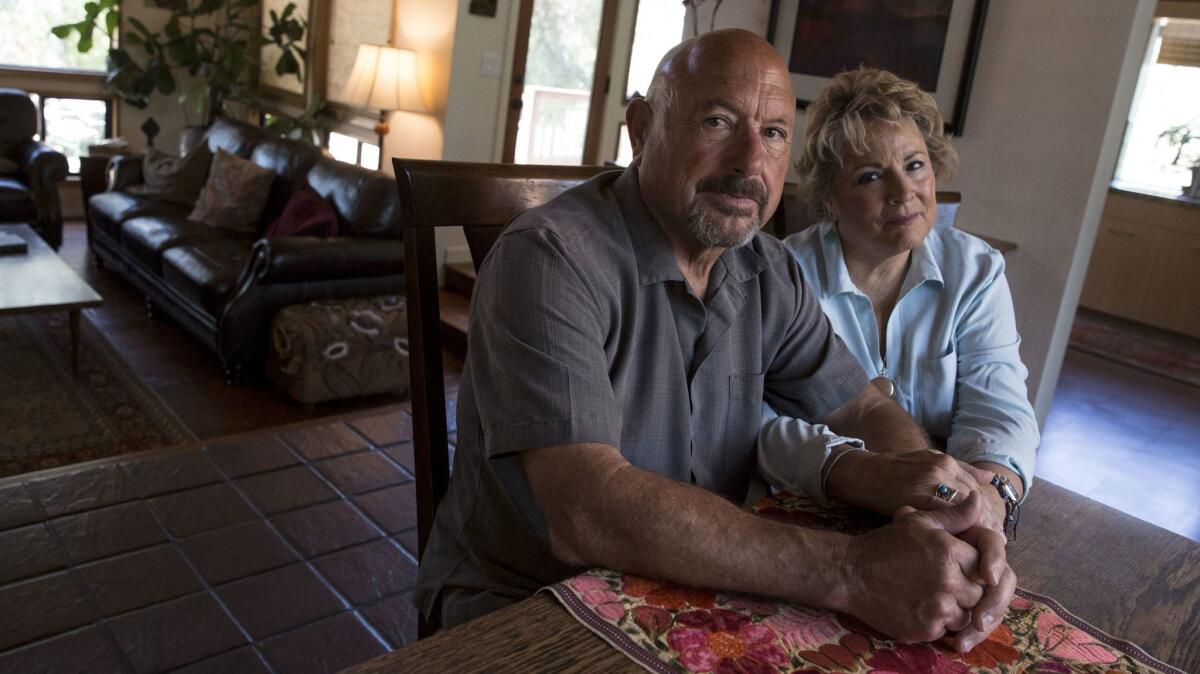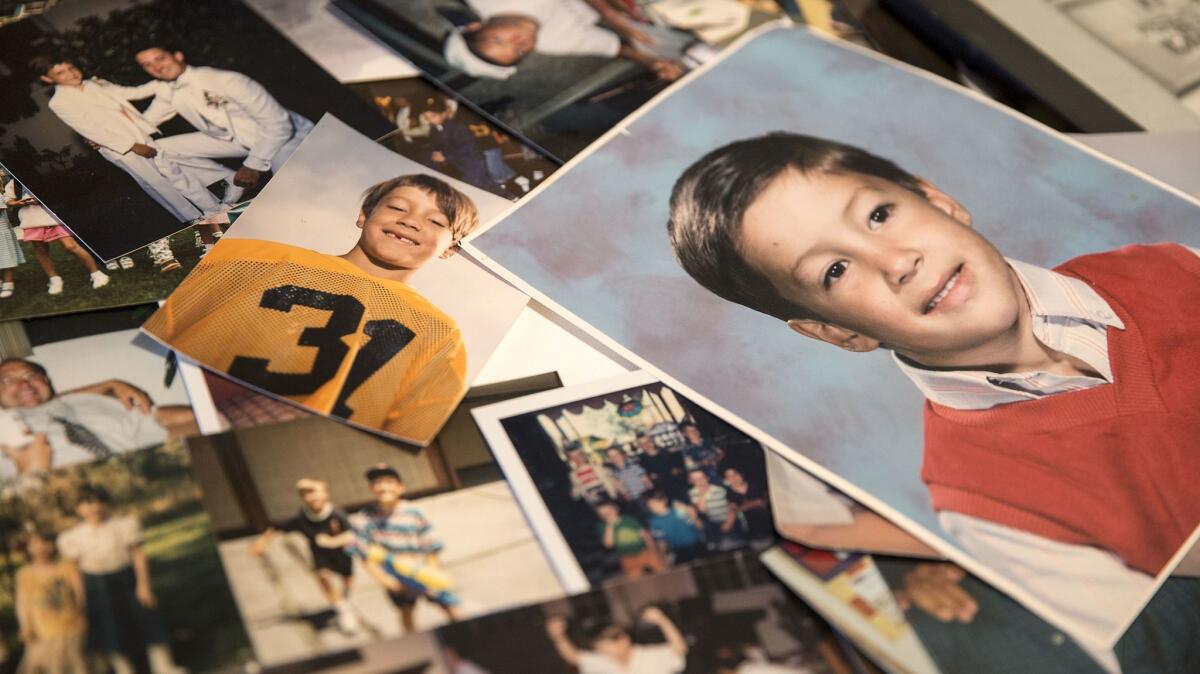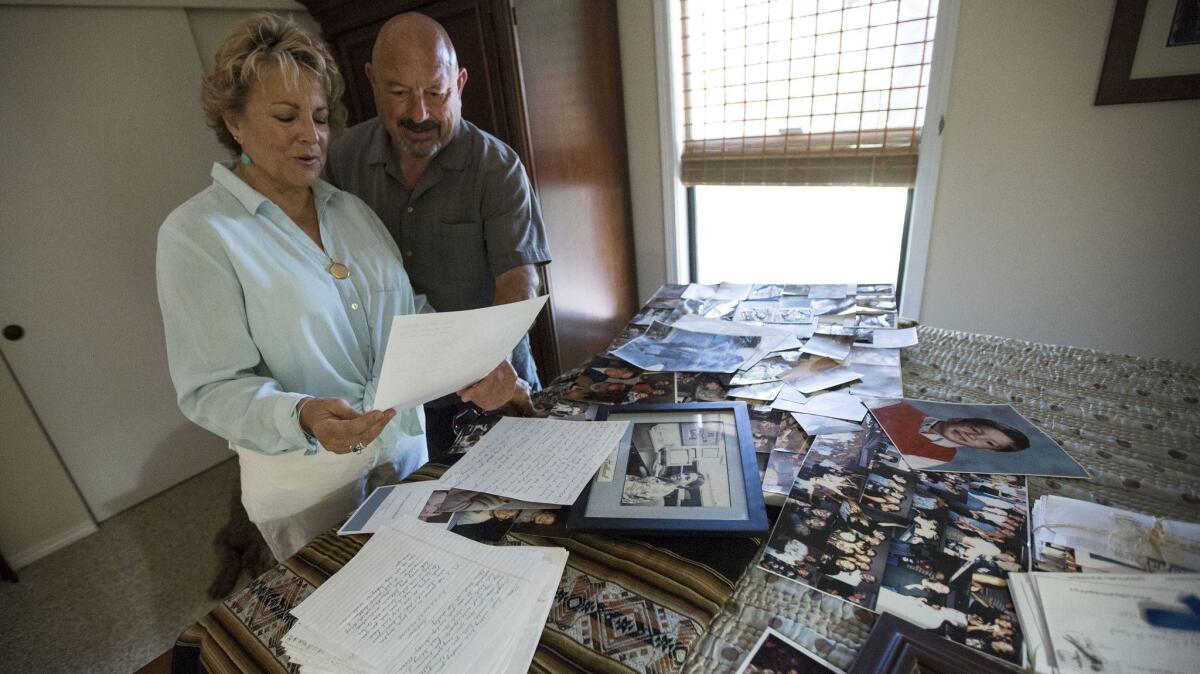Naked, filthy and strapped to a chair for 46 hours: a mentally ill inmate’s last days

Andrew Holland was strapped in a chair for 46 hours in the San Luis Obispo County Jail.
- Share via
Reporting from Atascadero, Calif. — For 46 hours, Andrew Holland’s legs and arms were shackled to a chair in the San Luis Obispo County jail.
The inmate, who suffered from schizophrenia, was left in his own filth, eating and drinking almost nothing. He was naked, except for a helmet and mask covering his face and a blanket that slipped off his lap, exposing him to jail staff who passed by his glass-fronted cell.
When he was finally unbound, guards dumped him to the floor of a nearby cell. Within 40 minutes, he had stopped breathing.

Holland’s death Jan. 22 has provoked outrage in the Central Coast county, a record $5-million legal settlement, and questions about the way California jails handle a sharp increase in the number of mentally ill inmates.
The surge in inmates requiring psychiatric care follows changes to California sentencing laws meant to reduce the state prison population, shifting offenders to county jails built to house those awaiting trial or serving short sentences rather than provide intensive, long-term care. At the same time, mental health experts say, an acute shortage of long-term care facilities makes it more likely that patients will experience a crisis that ends in their arrest, turning jails into the mental health centers of last resort.
After nearly three decades of federal litigation to establish that psychiatric care in prison is a constitutional right, advocates for the mentally ill now find themselves starting over. Unlike the centralized state prison system, counties operate independently and jail standards have few specific requirements. Mental health experts say most counties are ill-prepared for the challenge.
From 2012 to 2016, jails in California reported a 30% jump — from 13,270 to 17,350 — in the number of inmates identified as needing mental health services, according to the California Board of State and Community Corrections.
In 2015, Disability Rights California, an advocacy group that inspects detention centers, inspected jails in three counties — Sacramento, Santa Barbara and Sonoma — and reported shortfalls in them all, including excessive use of solitary confinement. Too often, jailers rely on isolation units to deal with prisoners afflicted with psychotic episodes or suicidal thoughts, said the organization’s counsel, Aaron Fischer.
“You can throw people in safety cells and take away their clothes, but it’s not treatment and it’s cruel,” he said.

Other counties, including Riverside, Fresno and Yuba, are embroiled in litigation alleging inadequate treatment for mentally ill inmates. In Marin, the county’s grand jury recently criticized the practice of holding mentally ill inmates in isolation cells for more than 24 hours, a treatment the panel said courts have ruled is “cruel and unusual punishment.”
In Santa Clara, three guards were recently convicted of second-degree murder for killing an inmate who suffered from bipolar disorder. And in Los Angeles County, home of the nation’s largest jail system, a federal monitor is overseeing efforts to address a previous surge in suicides, physical abuse of inmates and poor mental health treatment.
Holland’s death was one of three in nine months at the San Luis Obispo jail, including one inmate who slashed his arm with a razor blade. County grand jurors reviewing jail practices said they could not evaluate the role of mental healthcare in the deaths because the sheriff would not release medical records.The panel called for an independent investigation.
About 260 of the jail’s 600 inmates receive treatment for mental illness, according to the county.
Holland, a frequent inmate at the jail, had been incarcerated since September 2015 after a public disturbance in a city park led to his arrest for battling with local police. He faced additional charges for allegedly attempting to headbutt jailers, but the most recent of those charges was postponed in early January by a judge who ordered Holland sent to a psychiatric facility to be stabilized for competency to stand trial.
He was not moved. Instead, Holland remained in an isolation cell for 10 days until he was moved to a restraint chair when deputies saw him repeatedly strike himself in the face and head.
Though some departments cap the use of a chair restraint to two hours, the Sheriff’s Department policy allowed jailers to restrain inmates for up to 16 hours. The county has never explained why Holland was restrained for nearly two days.
A sheriff-coroner’s report concluded he died from a pulmonary embolism. A private autopsy conducted for Holland’s family went further, linking the embolism to deep vein thrombosis, the likely result of a blood clot in the leg caused by long immobility.
An FBI spokeswoman said agents launched a civil rights investigation into the county’s jail as a result of Holland’s death.
San Luis Obispo County Sheriff Ian Parkinson declined to discuss Holland’s case but in a statement said the inmate suffered from “a level of mental illness that could not be adequately addressed in county jail.” At a county board meeting this week, the sheriff and county mental health director conceded that jailers had been told there was no room for Holland at the county’s 16-bed psychiatric facility even though space became available. Jailers did not administer involuntary medication, despite a court order permitting it.
They attributed Holland’s death to “poor communication.”

The county said it has made “sweeping changes” that include discontinuing use of the restraint chair, making it easier to move inmates quickly to psychiatric facilities and improving training for jailers. Inmates will no longer spend more than 72 hours in an isolation cell, the county said.
Officials declined to say whether any jail staff have been disciplined.
Holland’s parents, Sharon and Carty, said they learned the full extent of their son’s ordeal only after they hired experts and investigators and watched jail surveillance recordings that captured his final two days.
They said their son’s mental health deteriorated in jail without proper care, and that they were refused permission to visit him or to pay so that he could receive his usual medication.
The Hollands hired Dr. Homer Venters, former chief medical officer of New York’s city jails, who toured the San Luis Obispo jail in June in preparation for litigation. Venters concluded the jail has no treatment facilities for mentally ill inmates. Five months after Holland’s death, he wrote, the jail still relied “on isolation as a primary response to mental health exacerbation.”
The surveillance video, Holland’s parents said, contradicts the Sheriff’s Department version of their son’s death, including the contention that jailers checked their restrained son twice every 30 minutes and regularly provided food, water and medical checks.
The Hollands, who watched the video, said they were struck by the number of jail staff who walked past their son, his head at times slumped to his chest, without taking notice of his condition.
“How could they treat my son as though he weren’t even human?” asked Sharon Holland. “I began to feel so sorry for them. They were less human than he was.”
Brian Hedley, a private investigator hired by the family, said he viewed the full recordings and that Holland appeared to be offered food only twice, and water infrequently.
The county reached the legal settlement with the Hollands before they filed a claim or lawsuit. The couple said county officials told them that the $5 million was the largest pre-litigation jail settlement in state history.
The county has refused to make the video public, but The Times viewed portions of the recordings and obtained Holland’s jail medical records.
Holland grew up in San Luis Obispo County, a building contractor’s son who spent his summers surfing. Symptoms of schizophrenia appeared when he was a teen, and he eventually started using illegal drugs.
He was jailed seven times over 10 years. Holland could be calm and passive when fully medicated but at other times was unpredictably violent, regarded by jail staff as a “full-restraint inmate with a history of ‘sucker punching,’” according to jail records.
He was often held in isolation for weeks, shocked by a Taser or doused with pepper spray. Twice in the month before his death jailers restrained him with a body binding system jailers call the “Wrap.”
How could they treat my son as though he weren’t even human?
— Sharon Holland, whose son Andrew died in the San Luis Obispo County jail
Holland’s condition deteriorated sharply in late November 2016 when, complaining of medication-induced muscle tremors, he stopped taking his pills.
On Jan. 20, he was in his isolation cell, smeared in his own feces, when jail staffers saw him repeatedly hit his head with his fists to the point he bled. Officers donned armor, preparing to force him out of the cell, but a family friend on staff talked Holland into cooperating.
The video shows Holland wheeled face-down on a gurney, arms chained to his waist behind his back, to a glass-fronted cell in a central area of the jail. There, jail logs state, a “relatively compliant” Holland was strapped into the restraint chair, his face obscured by a helmet and spit mask.
Jail staff entered his cell every few hours to massage his limbs to prevent blood clots. A mental health therapist wrote that Holland spit and cursed at them. The therapist said he repeatedly asked Holland to “commit to not harming himself any further” and when Holland refused, ordered he remain in the chair.
At several points, the blanket covering his lap fell, leaving his genitals exposed to anyone looking his way.
“Those images are always going to be with me,” Sharon Holland said, “in that chair, people walking by him and not helping him. Not paying any attention to him.
“And the very strange thing is,” she said as her voice cracked, “because I hadn’t seen him in so long, in some ways, even those images are dear.”
After nearly two days, Holland agreed not to harm himself. Within half an hour he was removed from the chair.
Two female inmates were brought in to mop up his urine and feces while Holland was placed, still naked, on the floor of the adjacent cell.
For the next half hour, the video shows jail staff visible through the cell’s glass front as Holland attempted to stand, collapsed and sprawled on the ground. He lay on his back with an arm resting on his head. Finally, the arm fell to the floor and he stopped moving.
Only then did jailers enter.
As emergency medical technicians perform CPR, the video shows deputies and two nurses standing by, watching. A deputy behind them turns his head toward someone off screen, laughing.
For updates and more, follow @paigestjohn.
ALSO
Orange County jail inmate found dead; five workers put on leave
More to Read
Sign up for Essential California
The most important California stories and recommendations in your inbox every morning.
You may occasionally receive promotional content from the Los Angeles Times.











